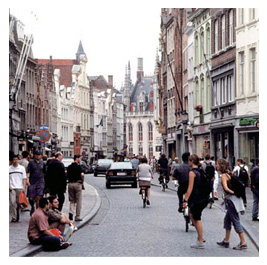 The parliamentary debate this week on improving conditions for cyclists raises a far wider question: Why do we put up death and injury on the roads at all?
The parliamentary debate this week on improving conditions for cyclists raises a far wider question: Why do we put up death and injury on the roads at all?
The number of people being killed on British roads may be falling, but other causes are going down quicker. In other words, road safety must be made a priority.
Professor of Human Geography at Sheffield University, Danny Dorling, believes that part of the problem lies in the fact that road safety falls under the remit of the department for transport – a body focussed completely on the movement of people – as opposed to the department for health. Each year road traffic collisions result in thousands of people passing through accident and emergency departments and many others are left disabled, so there is a logic in it being considered a health issue.
Why do we have streets and roads?
The purpose of a road is for motorised traffic to move from one place to another. Streets, on the other hand, have many uses and are based on people walking or even just standing or sitting.
The trouble is that there is not a clear boundary between a street and a road. A motorway is clearly a road, but sometimes a street, which should be a place of safety, has demands on it to become a road.
 Streets are for people and as such the speed should be low enough for people to communicate with each other by eye – even between drivers. The speed limit for streets should be 20mph. This is because research has shown that we find it next to impossible to make contact at higher speeds. Streets should not feel like a road. So no road markings (there might be a need for parking restrictions or parking bays. These should all be in yellow). No hatching or lane markings – no cycle paths, no footways – just places connecting homes and workplaces, parks and schools. I believe the default position for all towns should be that they only contain streets. However once you leave the town (unless you are wandering down a lane) you will enter the traffic domain of the road network. The speed limit is higher and the roadway is separate from the cycleway and footway. Here there are traffic lights, road markings, larger directional signs. Movements is by rules and codes. You should have no need to leave the road network until you reach your destination. Network traffic should not need to pass down streets.
Streets are for people and as such the speed should be low enough for people to communicate with each other by eye – even between drivers. The speed limit for streets should be 20mph. This is because research has shown that we find it next to impossible to make contact at higher speeds. Streets should not feel like a road. So no road markings (there might be a need for parking restrictions or parking bays. These should all be in yellow). No hatching or lane markings – no cycle paths, no footways – just places connecting homes and workplaces, parks and schools. I believe the default position for all towns should be that they only contain streets. However once you leave the town (unless you are wandering down a lane) you will enter the traffic domain of the road network. The speed limit is higher and the roadway is separate from the cycleway and footway. Here there are traffic lights, road markings, larger directional signs. Movements is by rules and codes. You should have no need to leave the road network until you reach your destination. Network traffic should not need to pass down streets.
To make this concept work drivers need to know, by the very look of a street that they are in, that they are in an area to which they have been invited but are not the hosts. They are there almost on sufferance. A driver also needs to know that these low speeds will not last long and that very soon the driver will pass on to a road with a higher speed limit.
0 Comments View now